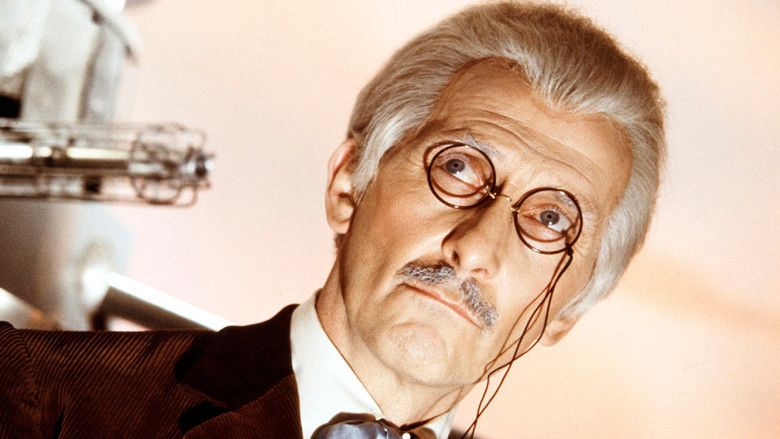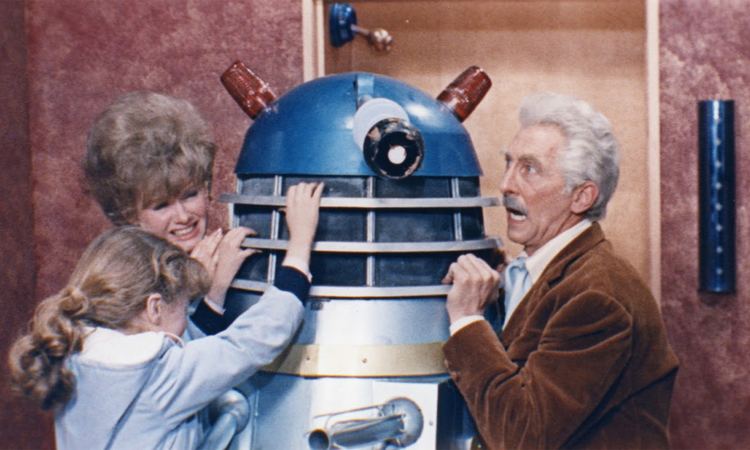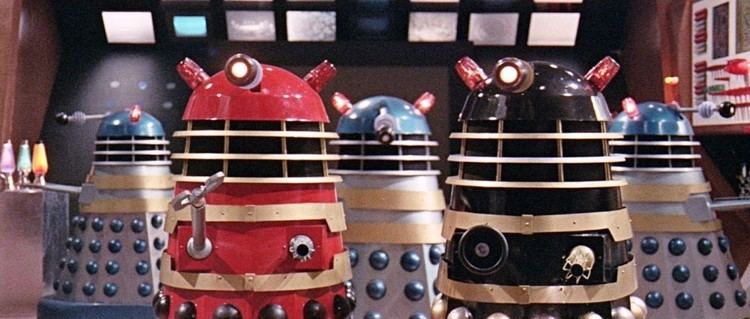Dr Who and the Daleks
4 /10 1 Votes
25% Rotten Tomatoes Genre Adventure, Family, Sci-Fi Country United Kingdom | 5.6/10 IMDb Duration Language English | |||||||||||||||||||||||||||||||||
 | ||||||||||||||||||||||||||||||||||
Release date 23 August 1965 (UK)July 1966 (US) Initial release August 23, 1965 (United Kingdom) Film series Dr. Who and the Daleks Film Series Cast (Doctor Who), (Ian), (Barbara), (Susan), (Alydon), (Ganatus) Similar movies Daleks' Invasion Earth: 2150 A.D. , Doctor Who: The Movie , Doctor Who: Dimensions in Time , An Adventure in Space and Time , Tagline Now on the Big Screen in COLOUR! | ||||||||||||||||||||||||||||||||||
1965 dr who and the daleks
Dr. Who and the Daleks is a 1965 British science fiction film directed by Gordon Flemyng and written by Milton Subotsky, and the first of two films based on the British science-fiction television series Doctor Who. It stars Peter Cushing as Dr. Who, Roberta Tovey as Susan, Jennie Linden as Barbara, and Roy Castle as Ian. It was followed by Daleks – Invasion Earth: 2150 A.D. (1966).
Contents
- 1965 dr who and the daleks
- Dr who and the daleks 1965 the countdown by malcolm lockyer
- Plot
- Production
- Dalek props
- Tie in products and later coverage
- Release and reception
- Marketing and box office
- Critical response
- References

The story is based on the Doctor Who television serial The Daleks, produced by the BBC. Filmed in Technicolor, it is the first Doctor Who story to be made in colour and in a widescreen format. The film was not intended to form part of the ongoing storylines of the television series. Elements from the programme are used, however, such as various characters, the Daleks and a police box time machine, albeit in re-imagined forms.

Dr who and the daleks 1965 the countdown by malcolm lockyer
Plot

Dr. Who, his two granddaughters Susan and Barbara and Barbara's boyfriend Ian are accidentally transported to a petrified jungle by Dr. Who's latest invention, a time and space machine called TARDIS.

The travellers explore, seeing a city in the distance. They also discover a small container of drugs which they take aboard TARDIS. Wishing to investigate further, Dr. Who fakes a leak in a fluid link, a vital component of TARDIS, to ensure that the group will go to the city to search for the mercury supposedly needed to refill the component. Once in the city they are captured by the Daleks, who seize the fluid link for examination. Dr. Who then realises that the group are developing radiation sickness and that the drugs they discovered earlier may be their only hope of survival.

While covertly observing the captives, the Daleks discuss their plight. They are trapped inside their metal casings and the city by the radiation. They wish to leave so that they can destroy all other life and claim the planet for themselves. Hearing the captives discussing the drugs, the Daleks visit their cell with a proposal. If the humans bring the drugs they have found to them, they will allow them enough to treat themselves. Susan volunteers to go, being the only one still strong enough to undertake the task.

Reaching TARDIS Susan encounters Alydon, leader of the few remaining Thals, a species that fought the Daleks in a catastrophic atomic war centuries previously. Alydon gives Susan a second container of anti-radiation drugs, to use if the Daleks fail to keep their promise, and a cape.

When Susan returns the Daleks discover the second drug supply, but allow the humans to treat themselves with it. Susan explains to her companions that, according to Alydon, the Thal crops have failed and they have come to the Dalek city, hoping to trade the anti-radiation drug formula for food. Again overhearing this conversation, the Daleks decide that they don’t need the Thals now that they have a sample of the drug. They get Susan to write a letter which they will leave for the Thals, stating that they want to end hostilities and will provide food, to be collected from the city, as an act of friendship. When Susan finishes the letter, the Daleks reveal that they plan to ambush and kill all of the Thals when they arrive.

Realising that the Daleks can see and overhear them via a wall-mounted device inside their cell, the travellers disable it and then hatch an escape plan. When a Dalek arrives to deliver food, they blind it by smearing some of it onto its eyestalk and force it onto the Thal cape, insulating it from the electrically charged metal floor providing its power. Ian then removes the Dalek creature from its casing and takes its place inside, pretending when challenged to be taking the captives for questioning. Once free, the travellers are able to shout a warning to the Thals who are entering the city and escape with them into the jungle, but not before one of the Thals is killed by the Daleks. The Daleks then test the Thal anti-radiation drug on a few of their number but find that it causes disastrous side effects. Thwarted, they decide to detonate a neutron bomb to increase the radiation on the planet to a level which even the Thals cannot survive.

Back at the Thal camp Dr. Who realises that the Daleks still have the fluid link, the TARDIS and its crew are thus trapped on the planet and the Thals are their only hope of retrieving the missing component. He urges Alydon to fight the Daleks to secure a safe future for his species but he refuses, insisting that the Thals are now peaceful. In response, Dr. Who tricks Alydon by pretending to order Ian to take a Thal woman to the Daleks in exchange for the confiscated component. Horrified, Alydon punches Ian to the ground, then realises that the Thals can fight for things they care about. Alydon, Dr. Who and Susan then lead the Thals in an attack on the city entrance. The Daleks foil the assault, however, and although most of the Thals escape, Dr. Who and Susan are recaptured.
Meanwhile, Ian and Barbara, guided by the Thals Ganatus, Antodus and Elyon, set out to infiltrate the city from the rear. While navigating a swamp Elyon is killed by a marsh-dwelling mutation. Later, Antodus nearly falls to his death while jumping across a ravine.
The Daleks start the bomb countdown. Ian, Barbara, Ganatus and Antodus penetrate the city and join Alydon and the rest of the Thals, who have returned to rescue Dr. Who and Susan. The Thals and humans enter the control room and struggle with the Daleks while Dr. Who yells for someone to stop the bomb detonation. Ian attracts the Daleks' attention and dives for cover as they fire at him, inadvertently destroying their main control console, killing themselves and freezing the countdown.
Back in the jungle, with the fluid link recovered, the travellers depart in TARDIS to return home. They arrive not in London, however, but in front of an advancing Roman army.
Production
Dalek props
The Daleks were redesigned slightly for the film. They had larger base sections, which made them taller and more imposing than the TV Daleks, which were only about five feet high. They had large, red dome lights and some were fitted with a two-jawed mechanical claw instead of a plunger. They also had more colourful paint schemes. Standard Daleks had blue domes, skirt balls and fenders, and gold collars. A Dalek leader was painted predominantly black and a second-in-command in red.
Originally the Daleks were to be armed with flamethrowers, but these were vetoed on health and safety grounds and because they were considered too frightening for a young audience. Instead, the guns produced jets of CO2 gas from internally mounted fire extinguishers. Some of the Daleks used in the background for crowd scenes were constructed from moulded fibreglass, and can be distinguished by the slightly different shape of the collars around their midsections.
Three of the movie Daleks were hired by the BBC and used in the serial The Chase. As the film was not released until after The Chase was screened, this television appearance is the first occasion that these props were seen by the public.
Tie-in products and later coverage
Release and reception
The film premiered in London on 23 August 1965.
Marketing and box-office
As part of the promotional campaign, a number of Daleks were displayed at the 1965 Cannes film festival. Single Daleks were also sent further afield, one making an appearance at a cinema in Sydney, Australia.
The film was the twentieth biggest British box office moneymaker in 1965. It did not perform as well in the US, however, where the Doctor Who television series and the Daleks were relatively unknown.
Critical response
Halliwell's Film Guide described the film as "limply put together, and only for indulgent children".
John Clute, in the book Science Fiction :The Illustrated Encyclopedia, gives the film one star out of three and states "Many people would like to see the [Doctor Who] television series back; few mourn the long-gone films".
Radio Times was more favourable, awarding the film three stars out of five and stating "this spin-off lacks the bite and inventiveness that set the landmark series apart, unwisely injecting humour into the sparse scenario, and the cheap art direction is strictly '101 Uses for Pink Plastic Sheeting'. However, despite the many faults, it's still a fun ride for both the uninitiated and die-hard fans alike".
References
Dr. Who and the Daleks WikipediaDr. Who and the Daleks IMDbDr. Who and the Daleks Rotten TomatoesDr Who and the Daleks themoviedb.org
